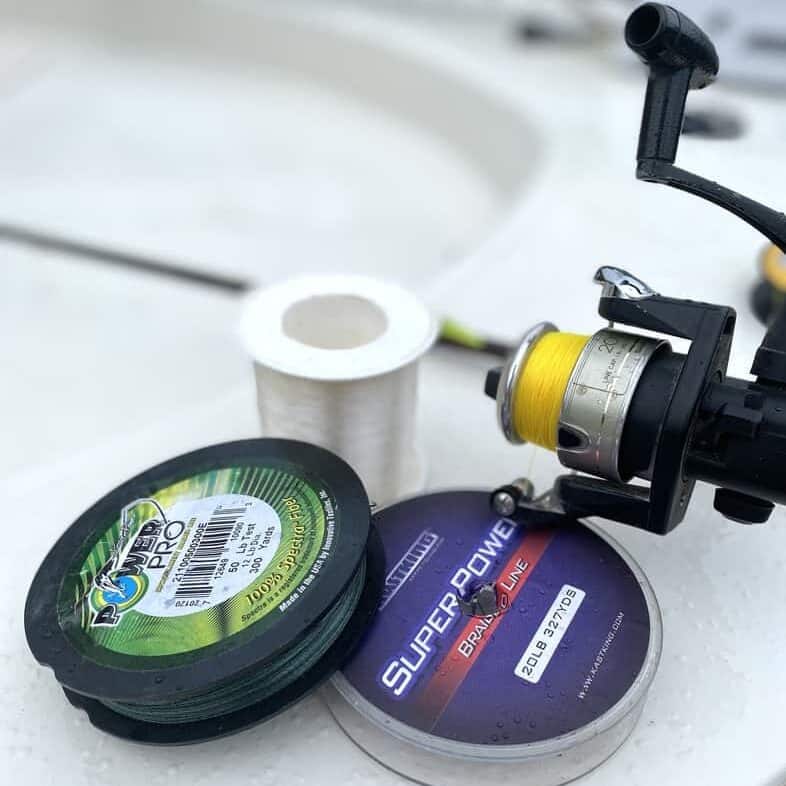
Red, blue, neon yellow…fishing line comes in all sorts of colors. But what are the differences between high vis vs low vis fishing line? And how do you know which one to use and when?
To gain an understanding of when it would be appropriate to use a high visibility line and low visibility line, let’s take a look at the pros and cons of each.
This page contains affiliate links. As an Amazon Associate, I earn from qualifying purchases.
Table of Contents
High Viz Line vs Low Viz Fishing Line What Are The Pros And Cons?
There are two main aspects and arguments for each type of line when it comes to high or low visibility; what is good for the angler and what is good for the fish.
After all, we all want to catch more fish right?
High visibility fishing line is specifically designed so it’s clearly visible to the angler, which makes it much easier to detect a bite and see where you are casting. It is also much easier to tie onto small hooks and tackle. Low visibility fishing line is designed to disappear in the water column, making it difficult for the fish to see your line, and therefore increase the chances of a bite.
The Pros of Using High Visibility Fishing Line
A brightly colored, high visibility line generally is used for two main benefits for the angler:
In dirty or muddy water, the high visibility line is easier for the fisherman to see. This offers some benefits for the angler, particularly when trying to see your line against the glare of the sun on the water.
A high visibility line will allow you to see where your line is in the water and where it enters the water, which gives you a better perspective of where your lure is under the water.
Knowing where your lure is will help you to avoid obstacles and track whether you are retrieving your lure too fast or too slow.

The second advantage of using a high visibility line is that you can see a bite on the line much sooner than feeling it on the rod.
Some fishermen check for bites by watching the rod tip, while others keep a finger on the line to feel the tension, and others still look for visual indication of a bite by watching the line. Other fishermen will use a combination of all three techniques to check for a bite (that’s what I do!).
The bright color of the line makes it easier for the fisherman to see movement on the line, which would indicate the fish is showing interest in the bait or the lure. This visual clue will often be noticeable before the tactile feedback will be noticeable on the line or the rod.
High visibility fishing lines are also easier to tie, especially in the low light of dawn or dusk. Being able to see the fishing line better makes tying knots a simpler endeavor.
| Type of Fishing | High Vis Fishing Line Options |
|---|---|
| Panfish (crappie, perch, etc) | Mr. Crappie High Vis Yellow (mono) |
| Bass Fishing | KastKing High Vis Yellow (braid) |
| Ice Fishing | Berkley Trilene Micro Ice (mono) |
| Catfish Fishing | Berkley Trilene Big Cat Green (mono) |
| Best All-Around | Stren High Impact Green (mono) |
The Cons of Using High Visibility Fishing Line
The disadvantages of using high visibility line are generally only applicable depending on the species of fish that you are targeting.
Most of the arguments against using a high visibility line on your rod are that if the line stands out in the water, it is visible to the fish, and it may discourage the fish from taking your bait. This is true for some species of fish that are very ‘line shy’ (hesitant to bite lures or bait when they can see the fishing line).
Fish that are voracious hunters, such as largemouth bass, are seldom discouraged from attacking a lure because of the color of the line.
They are so attracted by the motion and vibration of the lure that they almost cannot help themselves and hit the lure hard with no concern about whether the line was visible or not.
Other species of fish are more discerning feeders and can become wary of approaching your lure or the bait if the line is highly visible in the water.
This is true of some of the carp and trout species which can be wary feeders and discouraged from taking a bit of the lure if the line is too obvious in the water.
The Pros of Using Low Visibility Fishing Line
Many new fishermen consider low visibility fishing line to be clear line with no color. There are a number of colored lines that are marketed as low visibility lines, but they are intended to be used in certain color water.

Some low visibility lines are different shades of brown and are intended to be used in brown muddy waters where the brown color of the line will match the color of the water and effectively disappear.
Likewise, there are some green colored lines that are intended for use in green water to disguise the presence of the fishing line.
Some low visibility lines are camo-colored to mimic the shadows and vegetation under the water and can be used in waters where this type of environment is prevalent.
A clear fishing line is intended for use in crystal clear water, where the translucent nature of the fishing line will make it almost invisible to the fish.
The benefit that low visibility lines bring to your fishing experience is that the color of the line will not be a deterrent that will prevent the fish from taking a bit at your lure or bait.
| Type of Fishing | Low Vis Fishing Line Options |
|---|---|
| Panfish (crappie, perch, etc) | Berkley Trilene Sensation (mono) |
| Carp Fishing | Angryfish Sinking Low-Stretch (fluorocarbon) |
| Ice Fishing | Berkley Fireline Micro Ice (mono) |
| Trout Fishing | Berkley Vanish (fluorocarbon) |
| Best All-Around | Seaguar Red Label (fluorocarbon) |
The Cons of Using Low Visibility Fishing Line
The argument against low visibility lines is that they are equally difficult for the fisherman to see the line against the backdrop of the water that is the same color as the line.
This limits one of the feedback options that fishermen rely on to detect the fish showing interest in the bait at the end of their line.
While this is a minor adversity to overcome, it does require an angler to change their fishing style to accommodate the type of line they are using.
These reasons generally encourage fishermen to only use low visibility fishing line when they are specifically targeting a species of fish that are known to be sensitive to line color and may be difficult to entice to bite if they can see the line.
FAQ
Can Fish See High Vis Line?
Some fish can see high vis line, and it will discourage the fish from biting. The fishing depth that you are targeting will also affect the choice of line color. The deeper the water, the more certain colors are affected by the lack of light in the water.
Does Fishing Line Disappear Underwater?
Under the surface, light gradually loses its ability to penetrate the water column the deeper you go. Because of this, the fishing line, and anything under the surface gradually changes color, depending on the depth, water clarity, and other factors.
To read more about fishing line visibility under the surface, check out this article.
Is High Vis Line Good For Trout Fishing?
High vis line is not a great line choice when fishing for trout. Trout are one of the most hesitant and wary feeders, and they may be discouraged from biting if the line is blatantly visible in the water. Fluorocarbon line is a much better choice when fishing for trout.
Can Crappie See High Vis Line?
Crappie are not considered a picky fish species when it comes to line visibility. Many crappie anglers use high vis line to detect the ‘tink‘ movement of a subtle crappie bite.
Conclusion
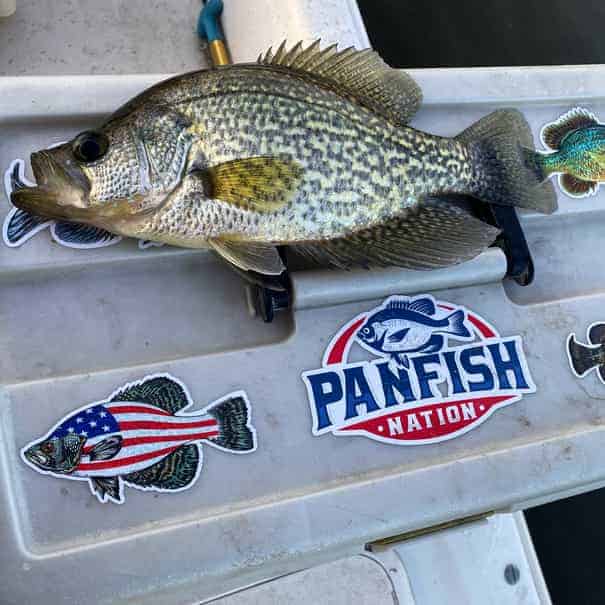
The debate between high vis vs low vis fishing line is that both types have their pros and cons in fishing.
Once you spend some time on the water, you will determine your style of fishing. Are you a line watcher (high vis) or a line-feeler (low vis)?
Consequently, most fishermen will carry an assortment of rods and reels spooled with different line colors in their tackle boxes so that they can adapt to the fishing conditions.
Remember, fishing line is only one small part of the equation. Many other factors such as bait, lure, presentation, location, time of year, and persistence all make a difference.
Thanks for reading and good luck the next time you are out fishing!
See Also: The definitive guide to fishing hook sizes, types, and uses!
Like this post? Save it on Pinterest.
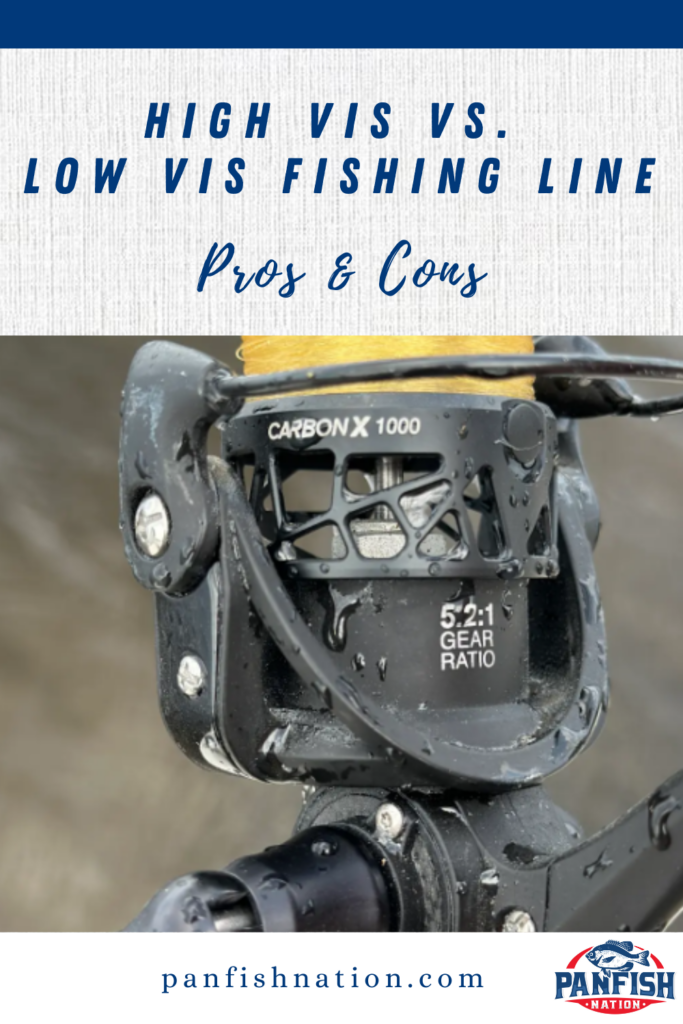
If you haven’t guessed yet, I love fishing and everything about it!
To learn more about why I started Panfish Nation, visit the About page and follow along on Social Media:


Download a copy of my FREE Lure Color Selection Chart & Knot Guide!
Stay up to date with fishing reports, tackle reviews, industry news, and much more! We respect your privacy, unsubscribe at any time.
- Sauger vs Walleye: Learn These Differences and Catch More!
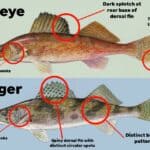
- How To Hold A Bluegill: Tips and Best Practices
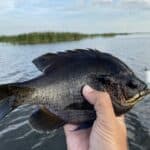
- How To Catch Wild Shiners For Bait (Step By Step W/Pics)
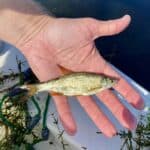
- Crazy Facts About the World Record Crappie

- What Size Hooks for Smallmouth Bass? Quick Guide

- Large and in Charge-Mouth: 10 of the Best Bass Lures of All Time (And Where to Buy Them)

